Public Health Report: Diphtheria Infection Impact on Rohingya Refugees
VerifiedAdded on 2021/05/31
|14
|3457
|28
Report
AI Summary
This report analyzes the diphtheria outbreak among Rohingya refugees, detailing the history of the infection, particularly its impact on the Rohingya population fleeing Myanmar to Bangladesh. The report explores the current situation, highlighting the number of cases, deaths, and the public health response, including vaccination programs and treatment strategies implemented by organizations like WHO and MSF. It covers the major highlights of the outbreak, including laboratory diagnosis methods, and evaluates various public health approaches such as health education, surveillance, and environmental controls. The report also examines intervention strategies to control the spread of the infection, treatment protocols, and the consequences of diphtheria. Finally, it offers recommendations to manage and mitigate the impact of this infectious disease within the refugee population.
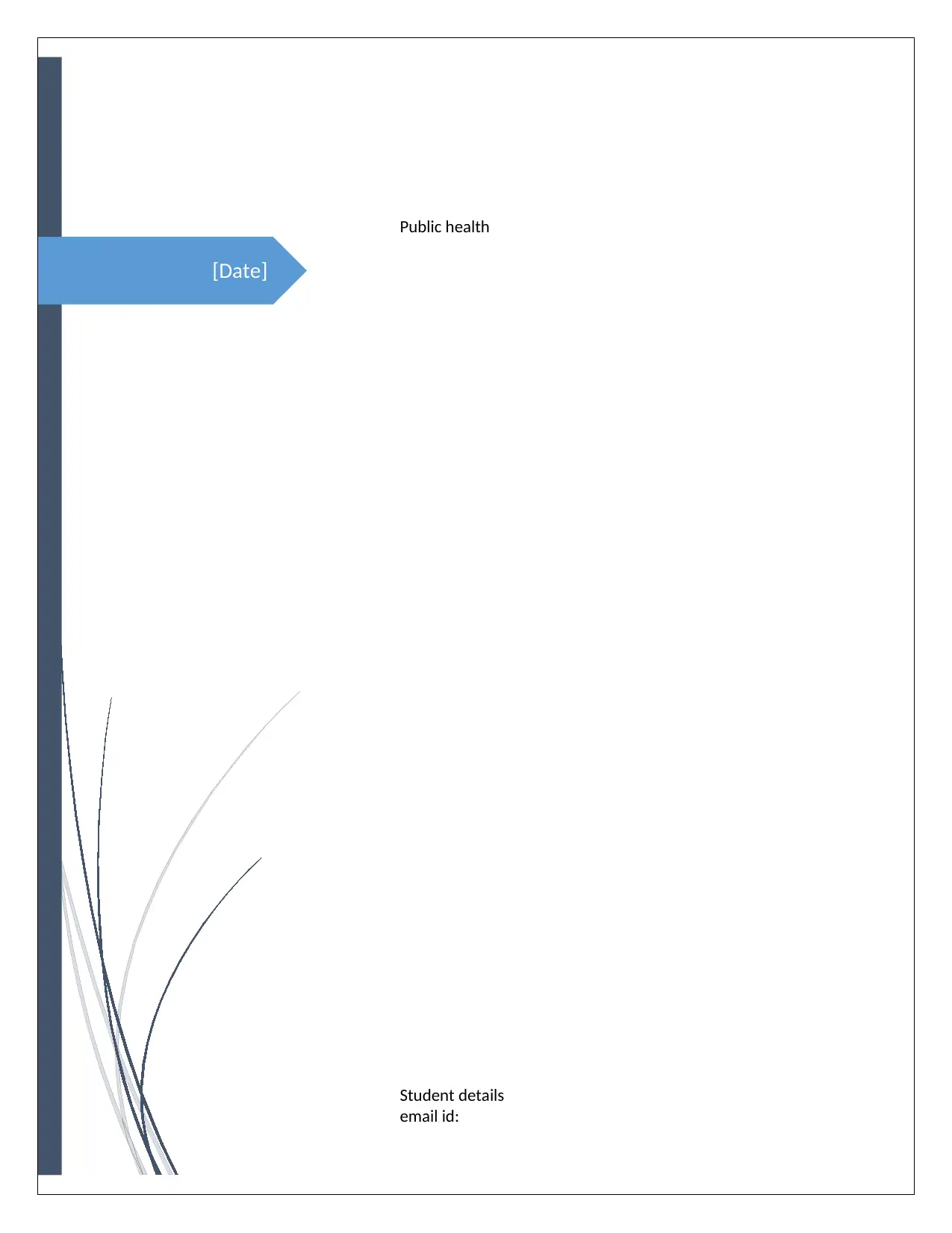
[Date]
Public health
Student details
email id:
Public health
Student details
email id:
Paraphrase This Document
Need a fresh take? Get an instant paraphrase of this document with our AI Paraphraser
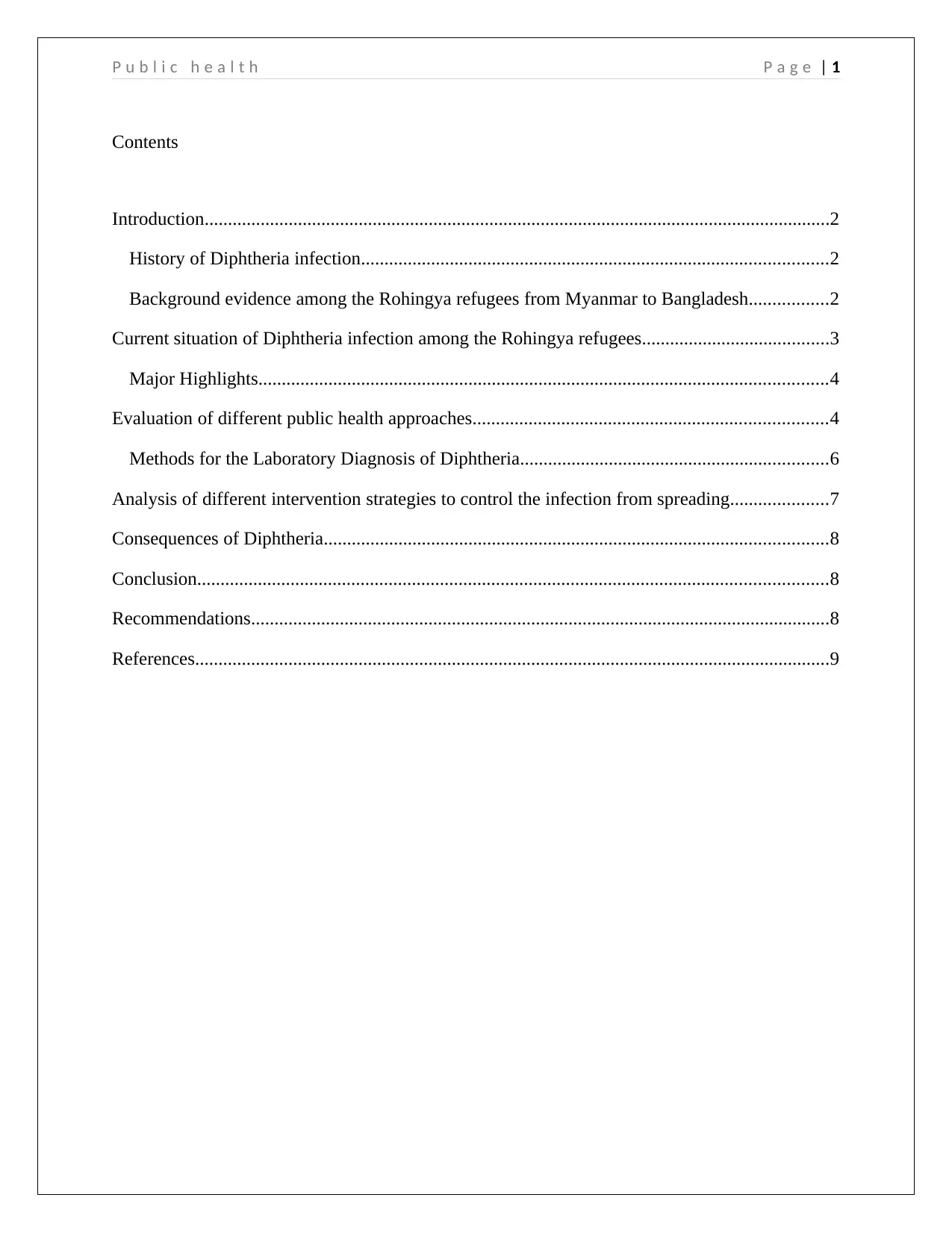
P u b l i c h e a l t h P a g e | 1
Contents
Introduction......................................................................................................................................2
History of Diphtheria infection....................................................................................................2
Background evidence among the Rohingya refugees from Myanmar to Bangladesh.................2
Current situation of Diphtheria infection among the Rohingya refugees........................................3
Major Highlights..........................................................................................................................4
Evaluation of different public health approaches............................................................................4
Methods for the Laboratory Diagnosis of Diphtheria..................................................................6
Analysis of different intervention strategies to control the infection from spreading.....................7
Consequences of Diphtheria............................................................................................................8
Conclusion.......................................................................................................................................8
Recommendations............................................................................................................................8
References........................................................................................................................................9
Contents
Introduction......................................................................................................................................2
History of Diphtheria infection....................................................................................................2
Background evidence among the Rohingya refugees from Myanmar to Bangladesh.................2
Current situation of Diphtheria infection among the Rohingya refugees........................................3
Major Highlights..........................................................................................................................4
Evaluation of different public health approaches............................................................................4
Methods for the Laboratory Diagnosis of Diphtheria..................................................................6
Analysis of different intervention strategies to control the infection from spreading.....................7
Consequences of Diphtheria............................................................................................................8
Conclusion.......................................................................................................................................8
Recommendations............................................................................................................................8
References........................................................................................................................................9
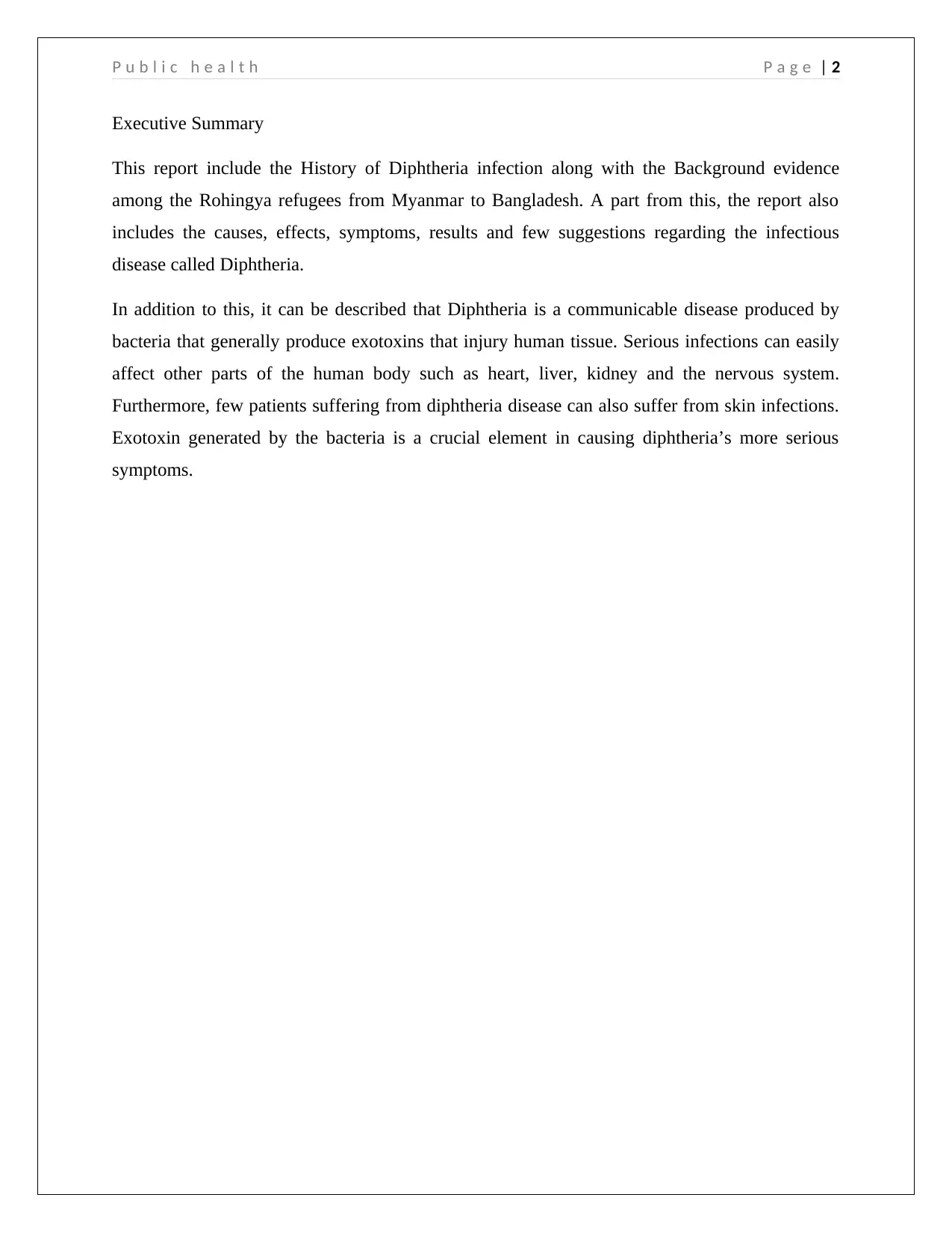
P u b l i c h e a l t h P a g e | 2
Executive Summary
This report include the History of Diphtheria infection along with the Background evidence
among the Rohingya refugees from Myanmar to Bangladesh. A part from this, the report also
includes the causes, effects, symptoms, results and few suggestions regarding the infectious
disease called Diphtheria.
In addition to this, it can be described that Diphtheria is a communicable disease produced by
bacteria that generally produce exotoxins that injury human tissue. Serious infections can easily
affect other parts of the human body such as heart, liver, kidney and the nervous system.
Furthermore, few patients suffering from diphtheria disease can also suffer from skin infections.
Exotoxin generated by the bacteria is a crucial element in causing diphtheria’s more serious
symptoms.
Executive Summary
This report include the History of Diphtheria infection along with the Background evidence
among the Rohingya refugees from Myanmar to Bangladesh. A part from this, the report also
includes the causes, effects, symptoms, results and few suggestions regarding the infectious
disease called Diphtheria.
In addition to this, it can be described that Diphtheria is a communicable disease produced by
bacteria that generally produce exotoxins that injury human tissue. Serious infections can easily
affect other parts of the human body such as heart, liver, kidney and the nervous system.
Furthermore, few patients suffering from diphtheria disease can also suffer from skin infections.
Exotoxin generated by the bacteria is a crucial element in causing diphtheria’s more serious
symptoms.
⊘ This is a preview!⊘
Do you want full access?
Subscribe today to unlock all pages.

Trusted by 1+ million students worldwide
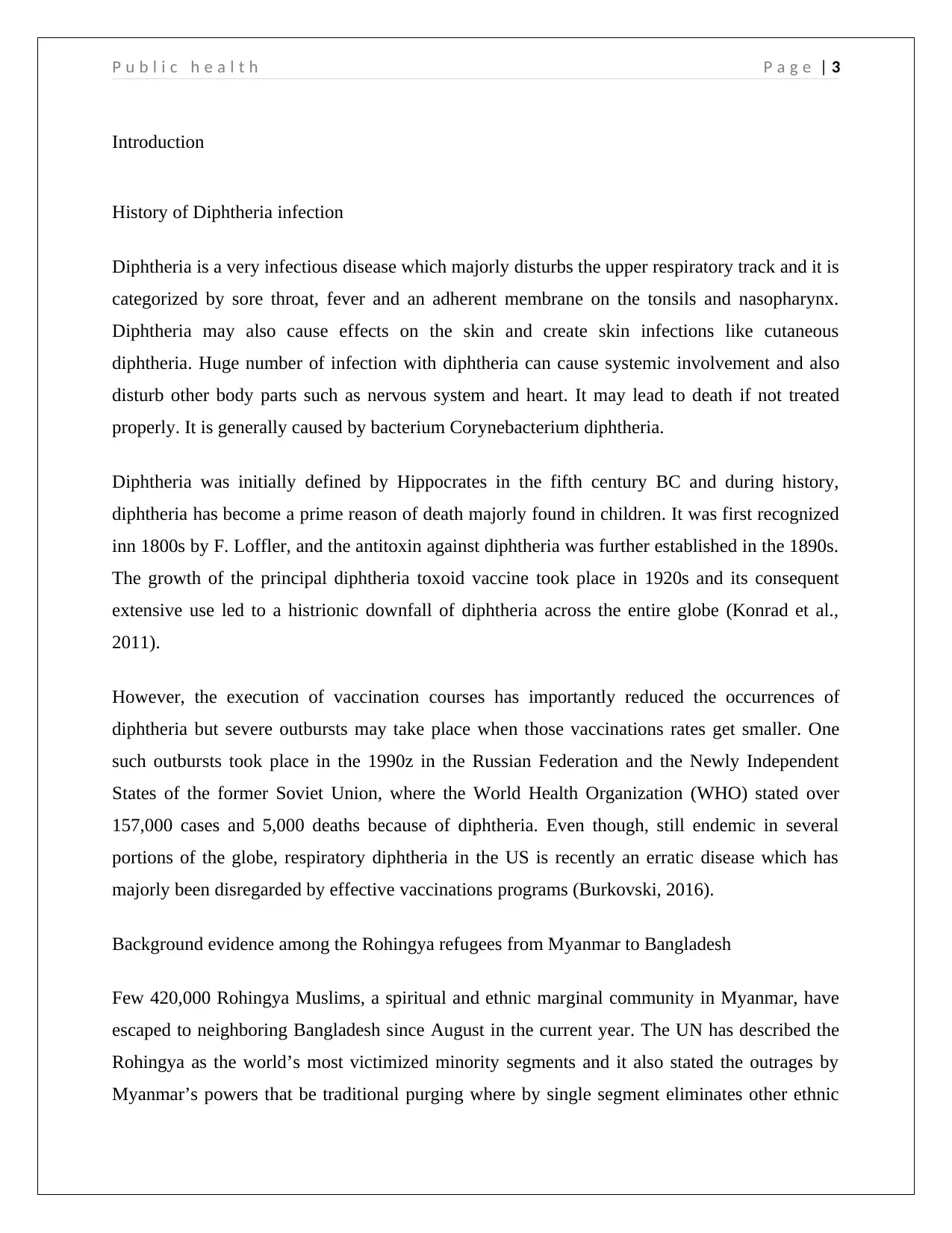
P u b l i c h e a l t h P a g e | 3
Introduction
History of Diphtheria infection
Diphtheria is a very infectious disease which majorly disturbs the upper respiratory track and it is
categorized by sore throat, fever and an adherent membrane on the tonsils and nasopharynx.
Diphtheria may also cause effects on the skin and create skin infections like cutaneous
diphtheria. Huge number of infection with diphtheria can cause systemic involvement and also
disturb other body parts such as nervous system and heart. It may lead to death if not treated
properly. It is generally caused by bacterium Corynebacterium diphtheria.
Diphtheria was initially defined by Hippocrates in the fifth century BC and during history,
diphtheria has become a prime reason of death majorly found in children. It was first recognized
inn 1800s by F. Loffler, and the antitoxin against diphtheria was further established in the 1890s.
The growth of the principal diphtheria toxoid vaccine took place in 1920s and its consequent
extensive use led to a histrionic downfall of diphtheria across the entire globe (Konrad et al.,
2011).
However, the execution of vaccination courses has importantly reduced the occurrences of
diphtheria but severe outbursts may take place when those vaccinations rates get smaller. One
such outbursts took place in the 1990z in the Russian Federation and the Newly Independent
States of the former Soviet Union, where the World Health Organization (WHO) stated over
157,000 cases and 5,000 deaths because of diphtheria. Even though, still endemic in several
portions of the globe, respiratory diphtheria in the US is recently an erratic disease which has
majorly been disregarded by effective vaccinations programs (Burkovski, 2016).
Background evidence among the Rohingya refugees from Myanmar to Bangladesh
Few 420,000 Rohingya Muslims, a spiritual and ethnic marginal community in Myanmar, have
escaped to neighboring Bangladesh since August in the current year. The UN has described the
Rohingya as the world’s most victimized minority segments and it also stated the outrages by
Myanmar’s powers that be traditional purging where by single segment eliminates other ethnic
Introduction
History of Diphtheria infection
Diphtheria is a very infectious disease which majorly disturbs the upper respiratory track and it is
categorized by sore throat, fever and an adherent membrane on the tonsils and nasopharynx.
Diphtheria may also cause effects on the skin and create skin infections like cutaneous
diphtheria. Huge number of infection with diphtheria can cause systemic involvement and also
disturb other body parts such as nervous system and heart. It may lead to death if not treated
properly. It is generally caused by bacterium Corynebacterium diphtheria.
Diphtheria was initially defined by Hippocrates in the fifth century BC and during history,
diphtheria has become a prime reason of death majorly found in children. It was first recognized
inn 1800s by F. Loffler, and the antitoxin against diphtheria was further established in the 1890s.
The growth of the principal diphtheria toxoid vaccine took place in 1920s and its consequent
extensive use led to a histrionic downfall of diphtheria across the entire globe (Konrad et al.,
2011).
However, the execution of vaccination courses has importantly reduced the occurrences of
diphtheria but severe outbursts may take place when those vaccinations rates get smaller. One
such outbursts took place in the 1990z in the Russian Federation and the Newly Independent
States of the former Soviet Union, where the World Health Organization (WHO) stated over
157,000 cases and 5,000 deaths because of diphtheria. Even though, still endemic in several
portions of the globe, respiratory diphtheria in the US is recently an erratic disease which has
majorly been disregarded by effective vaccinations programs (Burkovski, 2016).
Background evidence among the Rohingya refugees from Myanmar to Bangladesh
Few 420,000 Rohingya Muslims, a spiritual and ethnic marginal community in Myanmar, have
escaped to neighboring Bangladesh since August in the current year. The UN has described the
Rohingya as the world’s most victimized minority segments and it also stated the outrages by
Myanmar’s powers that be traditional purging where by single segment eliminates other ethnic
Paraphrase This Document
Need a fresh take? Get an instant paraphrase of this document with our AI Paraphraser
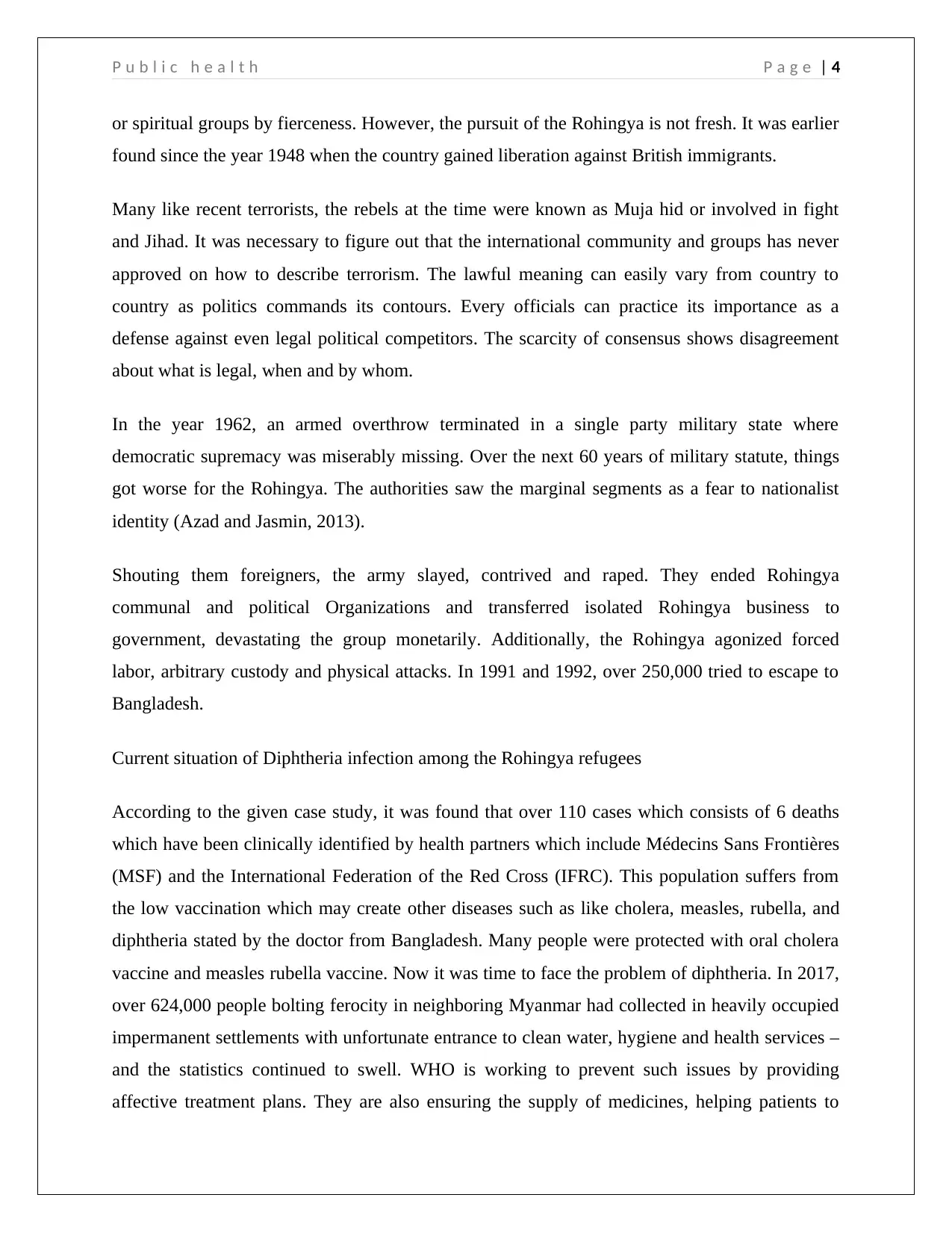
P u b l i c h e a l t h P a g e | 4
or spiritual groups by fierceness. However, the pursuit of the Rohingya is not fresh. It was earlier
found since the year 1948 when the country gained liberation against British immigrants.
Many like recent terrorists, the rebels at the time were known as Muja hid or involved in fight
and Jihad. It was necessary to figure out that the international community and groups has never
approved on how to describe terrorism. The lawful meaning can easily vary from country to
country as politics commands its contours. Every officials can practice its importance as a
defense against even legal political competitors. The scarcity of consensus shows disagreement
about what is legal, when and by whom.
In the year 1962, an armed overthrow terminated in a single party military state where
democratic supremacy was miserably missing. Over the next 60 years of military statute, things
got worse for the Rohingya. The authorities saw the marginal segments as a fear to nationalist
identity (Azad and Jasmin, 2013).
Shouting them foreigners, the army slayed, contrived and raped. They ended Rohingya
communal and political Organizations and transferred isolated Rohingya business to
government, devastating the group monetarily. Additionally, the Rohingya agonized forced
labor, arbitrary custody and physical attacks. In 1991 and 1992, over 250,000 tried to escape to
Bangladesh.
Current situation of Diphtheria infection among the Rohingya refugees
According to the given case study, it was found that over 110 cases which consists of 6 deaths
which have been clinically identified by health partners which include Médecins Sans Frontières
(MSF) and the International Federation of the Red Cross (IFRC). This population suffers from
the low vaccination which may create other diseases such as like cholera, measles, rubella, and
diphtheria stated by the doctor from Bangladesh. Many people were protected with oral cholera
vaccine and measles rubella vaccine. Now it was time to face the problem of diphtheria. In 2017,
over 624,000 people bolting ferocity in neighboring Myanmar had collected in heavily occupied
impermanent settlements with unfortunate entrance to clean water, hygiene and health services –
and the statistics continued to swell. WHO is working to prevent such issues by providing
affective treatment plans. They are also ensuring the supply of medicines, helping patients to
or spiritual groups by fierceness. However, the pursuit of the Rohingya is not fresh. It was earlier
found since the year 1948 when the country gained liberation against British immigrants.
Many like recent terrorists, the rebels at the time were known as Muja hid or involved in fight
and Jihad. It was necessary to figure out that the international community and groups has never
approved on how to describe terrorism. The lawful meaning can easily vary from country to
country as politics commands its contours. Every officials can practice its importance as a
defense against even legal political competitors. The scarcity of consensus shows disagreement
about what is legal, when and by whom.
In the year 1962, an armed overthrow terminated in a single party military state where
democratic supremacy was miserably missing. Over the next 60 years of military statute, things
got worse for the Rohingya. The authorities saw the marginal segments as a fear to nationalist
identity (Azad and Jasmin, 2013).
Shouting them foreigners, the army slayed, contrived and raped. They ended Rohingya
communal and political Organizations and transferred isolated Rohingya business to
government, devastating the group monetarily. Additionally, the Rohingya agonized forced
labor, arbitrary custody and physical attacks. In 1991 and 1992, over 250,000 tried to escape to
Bangladesh.
Current situation of Diphtheria infection among the Rohingya refugees
According to the given case study, it was found that over 110 cases which consists of 6 deaths
which have been clinically identified by health partners which include Médecins Sans Frontières
(MSF) and the International Federation of the Red Cross (IFRC). This population suffers from
the low vaccination which may create other diseases such as like cholera, measles, rubella, and
diphtheria stated by the doctor from Bangladesh. Many people were protected with oral cholera
vaccine and measles rubella vaccine. Now it was time to face the problem of diphtheria. In 2017,
over 624,000 people bolting ferocity in neighboring Myanmar had collected in heavily occupied
impermanent settlements with unfortunate entrance to clean water, hygiene and health services –
and the statistics continued to swell. WHO is working to prevent such issues by providing
affective treatment plans. They are also ensuring the supply of medicines, helping patients to
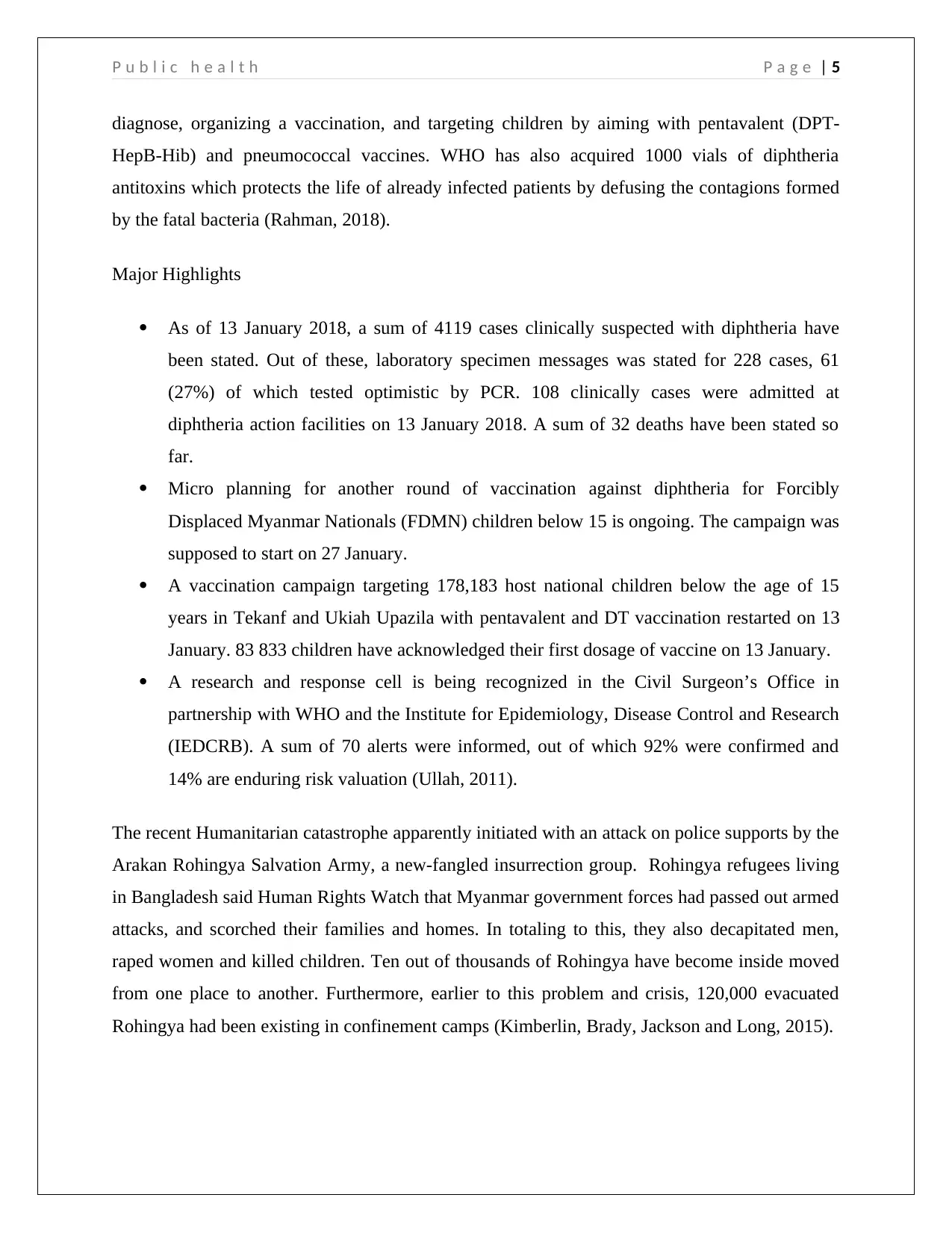
P u b l i c h e a l t h P a g e | 5
diagnose, organizing a vaccination, and targeting children by aiming with pentavalent (DPT-
HepB-Hib) and pneumococcal vaccines. WHO has also acquired 1000 vials of diphtheria
antitoxins which protects the life of already infected patients by defusing the contagions formed
by the fatal bacteria (Rahman, 2018).
Major Highlights
As of 13 January 2018, a sum of 4119 cases clinically suspected with diphtheria have
been stated. Out of these, laboratory specimen messages was stated for 228 cases, 61
(27%) of which tested optimistic by PCR. 108 clinically cases were admitted at
diphtheria action facilities on 13 January 2018. A sum of 32 deaths have been stated so
far.
Micro planning for another round of vaccination against diphtheria for Forcibly
Displaced Myanmar Nationals (FDMN) children below 15 is ongoing. The campaign was
supposed to start on 27 January.
A vaccination campaign targeting 178,183 host national children below the age of 15
years in Tekanf and Ukiah Upazila with pentavalent and DT vaccination restarted on 13
January. 83 833 children have acknowledged their first dosage of vaccine on 13 January.
A research and response cell is being recognized in the Civil Surgeon’s Office in
partnership with WHO and the Institute for Epidemiology, Disease Control and Research
(IEDCRB). A sum of 70 alerts were informed, out of which 92% were confirmed and
14% are enduring risk valuation (Ullah, 2011).
The recent Humanitarian catastrophe apparently initiated with an attack on police supports by the
Arakan Rohingya Salvation Army, a new-fangled insurrection group. Rohingya refugees living
in Bangladesh said Human Rights Watch that Myanmar government forces had passed out armed
attacks, and scorched their families and homes. In totaling to this, they also decapitated men,
raped women and killed children. Ten out of thousands of Rohingya have become inside moved
from one place to another. Furthermore, earlier to this problem and crisis, 120,000 evacuated
Rohingya had been existing in confinement camps (Kimberlin, Brady, Jackson and Long, 2015).
diagnose, organizing a vaccination, and targeting children by aiming with pentavalent (DPT-
HepB-Hib) and pneumococcal vaccines. WHO has also acquired 1000 vials of diphtheria
antitoxins which protects the life of already infected patients by defusing the contagions formed
by the fatal bacteria (Rahman, 2018).
Major Highlights
As of 13 January 2018, a sum of 4119 cases clinically suspected with diphtheria have
been stated. Out of these, laboratory specimen messages was stated for 228 cases, 61
(27%) of which tested optimistic by PCR. 108 clinically cases were admitted at
diphtheria action facilities on 13 January 2018. A sum of 32 deaths have been stated so
far.
Micro planning for another round of vaccination against diphtheria for Forcibly
Displaced Myanmar Nationals (FDMN) children below 15 is ongoing. The campaign was
supposed to start on 27 January.
A vaccination campaign targeting 178,183 host national children below the age of 15
years in Tekanf and Ukiah Upazila with pentavalent and DT vaccination restarted on 13
January. 83 833 children have acknowledged their first dosage of vaccine on 13 January.
A research and response cell is being recognized in the Civil Surgeon’s Office in
partnership with WHO and the Institute for Epidemiology, Disease Control and Research
(IEDCRB). A sum of 70 alerts were informed, out of which 92% were confirmed and
14% are enduring risk valuation (Ullah, 2011).
The recent Humanitarian catastrophe apparently initiated with an attack on police supports by the
Arakan Rohingya Salvation Army, a new-fangled insurrection group. Rohingya refugees living
in Bangladesh said Human Rights Watch that Myanmar government forces had passed out armed
attacks, and scorched their families and homes. In totaling to this, they also decapitated men,
raped women and killed children. Ten out of thousands of Rohingya have become inside moved
from one place to another. Furthermore, earlier to this problem and crisis, 120,000 evacuated
Rohingya had been existing in confinement camps (Kimberlin, Brady, Jackson and Long, 2015).
⊘ This is a preview!⊘
Do you want full access?
Subscribe today to unlock all pages.

Trusted by 1+ million students worldwide
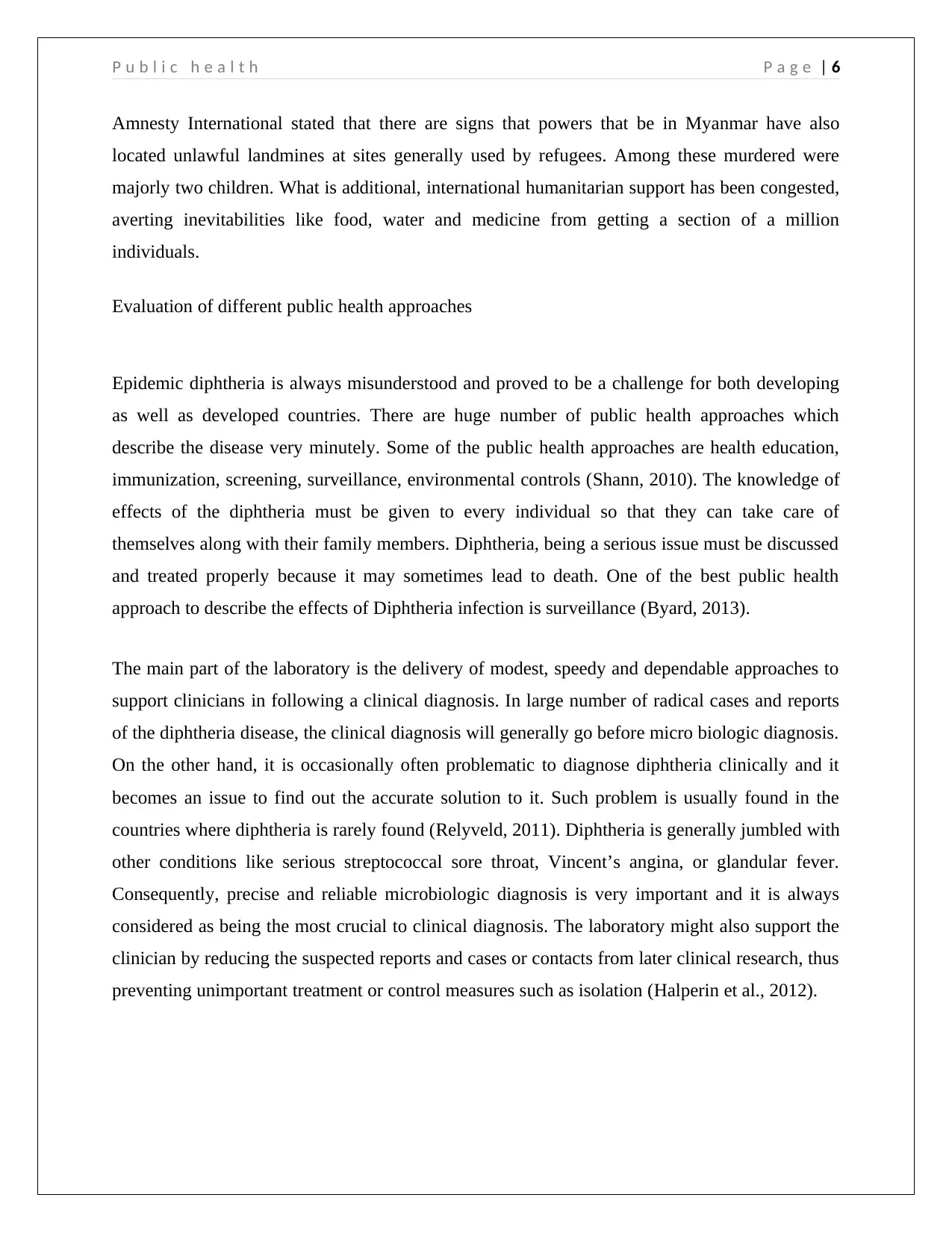
P u b l i c h e a l t h P a g e | 6
Amnesty International stated that there are signs that powers that be in Myanmar have also
located unlawful landmines at sites generally used by refugees. Among these murdered were
majorly two children. What is additional, international humanitarian support has been congested,
averting inevitabilities like food, water and medicine from getting a section of a million
individuals.
Evaluation of different public health approaches
Epidemic diphtheria is always misunderstood and proved to be a challenge for both developing
as well as developed countries. There are huge number of public health approaches which
describe the disease very minutely. Some of the public health approaches are health education,
immunization, screening, surveillance, environmental controls (Shann, 2010). The knowledge of
effects of the diphtheria must be given to every individual so that they can take care of
themselves along with their family members. Diphtheria, being a serious issue must be discussed
and treated properly because it may sometimes lead to death. One of the best public health
approach to describe the effects of Diphtheria infection is surveillance (Byard, 2013).
The main part of the laboratory is the delivery of modest, speedy and dependable approaches to
support clinicians in following a clinical diagnosis. In large number of radical cases and reports
of the diphtheria disease, the clinical diagnosis will generally go before micro biologic diagnosis.
On the other hand, it is occasionally often problematic to diagnose diphtheria clinically and it
becomes an issue to find out the accurate solution to it. Such problem is usually found in the
countries where diphtheria is rarely found (Relyveld, 2011). Diphtheria is generally jumbled with
other conditions like serious streptococcal sore throat, Vincent’s angina, or glandular fever.
Consequently, precise and reliable microbiologic diagnosis is very important and it is always
considered as being the most crucial to clinical diagnosis. The laboratory might also support the
clinician by reducing the suspected reports and cases or contacts from later clinical research, thus
preventing unimportant treatment or control measures such as isolation (Halperin et al., 2012).
Amnesty International stated that there are signs that powers that be in Myanmar have also
located unlawful landmines at sites generally used by refugees. Among these murdered were
majorly two children. What is additional, international humanitarian support has been congested,
averting inevitabilities like food, water and medicine from getting a section of a million
individuals.
Evaluation of different public health approaches
Epidemic diphtheria is always misunderstood and proved to be a challenge for both developing
as well as developed countries. There are huge number of public health approaches which
describe the disease very minutely. Some of the public health approaches are health education,
immunization, screening, surveillance, environmental controls (Shann, 2010). The knowledge of
effects of the diphtheria must be given to every individual so that they can take care of
themselves along with their family members. Diphtheria, being a serious issue must be discussed
and treated properly because it may sometimes lead to death. One of the best public health
approach to describe the effects of Diphtheria infection is surveillance (Byard, 2013).
The main part of the laboratory is the delivery of modest, speedy and dependable approaches to
support clinicians in following a clinical diagnosis. In large number of radical cases and reports
of the diphtheria disease, the clinical diagnosis will generally go before micro biologic diagnosis.
On the other hand, it is occasionally often problematic to diagnose diphtheria clinically and it
becomes an issue to find out the accurate solution to it. Such problem is usually found in the
countries where diphtheria is rarely found (Relyveld, 2011). Diphtheria is generally jumbled with
other conditions like serious streptococcal sore throat, Vincent’s angina, or glandular fever.
Consequently, precise and reliable microbiologic diagnosis is very important and it is always
considered as being the most crucial to clinical diagnosis. The laboratory might also support the
clinician by reducing the suspected reports and cases or contacts from later clinical research, thus
preventing unimportant treatment or control measures such as isolation (Halperin et al., 2012).
Paraphrase This Document
Need a fresh take? Get an instant paraphrase of this document with our AI Paraphraser
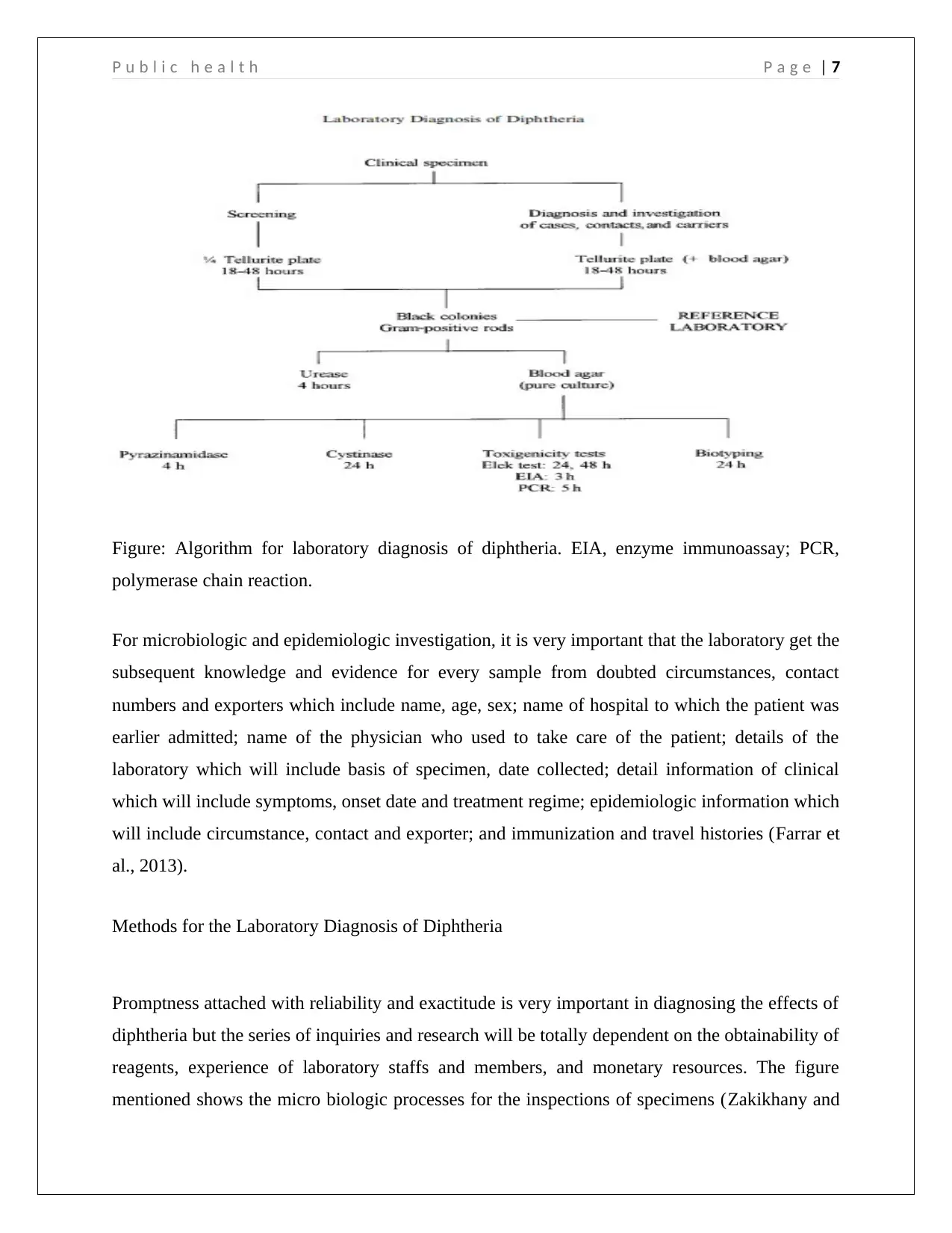
P u b l i c h e a l t h P a g e | 7
Figure: Algorithm for laboratory diagnosis of diphtheria. EIA, enzyme immunoassay; PCR,
polymerase chain reaction.
For microbiologic and epidemiologic investigation, it is very important that the laboratory get the
subsequent knowledge and evidence for every sample from doubted circumstances, contact
numbers and exporters which include name, age, sex; name of hospital to which the patient was
earlier admitted; name of the physician who used to take care of the patient; details of the
laboratory which will include basis of specimen, date collected; detail information of clinical
which will include symptoms, onset date and treatment regime; epidemiologic information which
will include circumstance, contact and exporter; and immunization and travel histories (Farrar et
al., 2013).
Methods for the Laboratory Diagnosis of Diphtheria
Promptness attached with reliability and exactitude is very important in diagnosing the effects of
diphtheria but the series of inquiries and research will be totally dependent on the obtainability of
reagents, experience of laboratory staffs and members, and monetary resources. The figure
mentioned shows the micro biologic processes for the inspections of specimens (Zakikhany and
Figure: Algorithm for laboratory diagnosis of diphtheria. EIA, enzyme immunoassay; PCR,
polymerase chain reaction.
For microbiologic and epidemiologic investigation, it is very important that the laboratory get the
subsequent knowledge and evidence for every sample from doubted circumstances, contact
numbers and exporters which include name, age, sex; name of hospital to which the patient was
earlier admitted; name of the physician who used to take care of the patient; details of the
laboratory which will include basis of specimen, date collected; detail information of clinical
which will include symptoms, onset date and treatment regime; epidemiologic information which
will include circumstance, contact and exporter; and immunization and travel histories (Farrar et
al., 2013).
Methods for the Laboratory Diagnosis of Diphtheria
Promptness attached with reliability and exactitude is very important in diagnosing the effects of
diphtheria but the series of inquiries and research will be totally dependent on the obtainability of
reagents, experience of laboratory staffs and members, and monetary resources. The figure
mentioned shows the micro biologic processes for the inspections of specimens (Zakikhany and
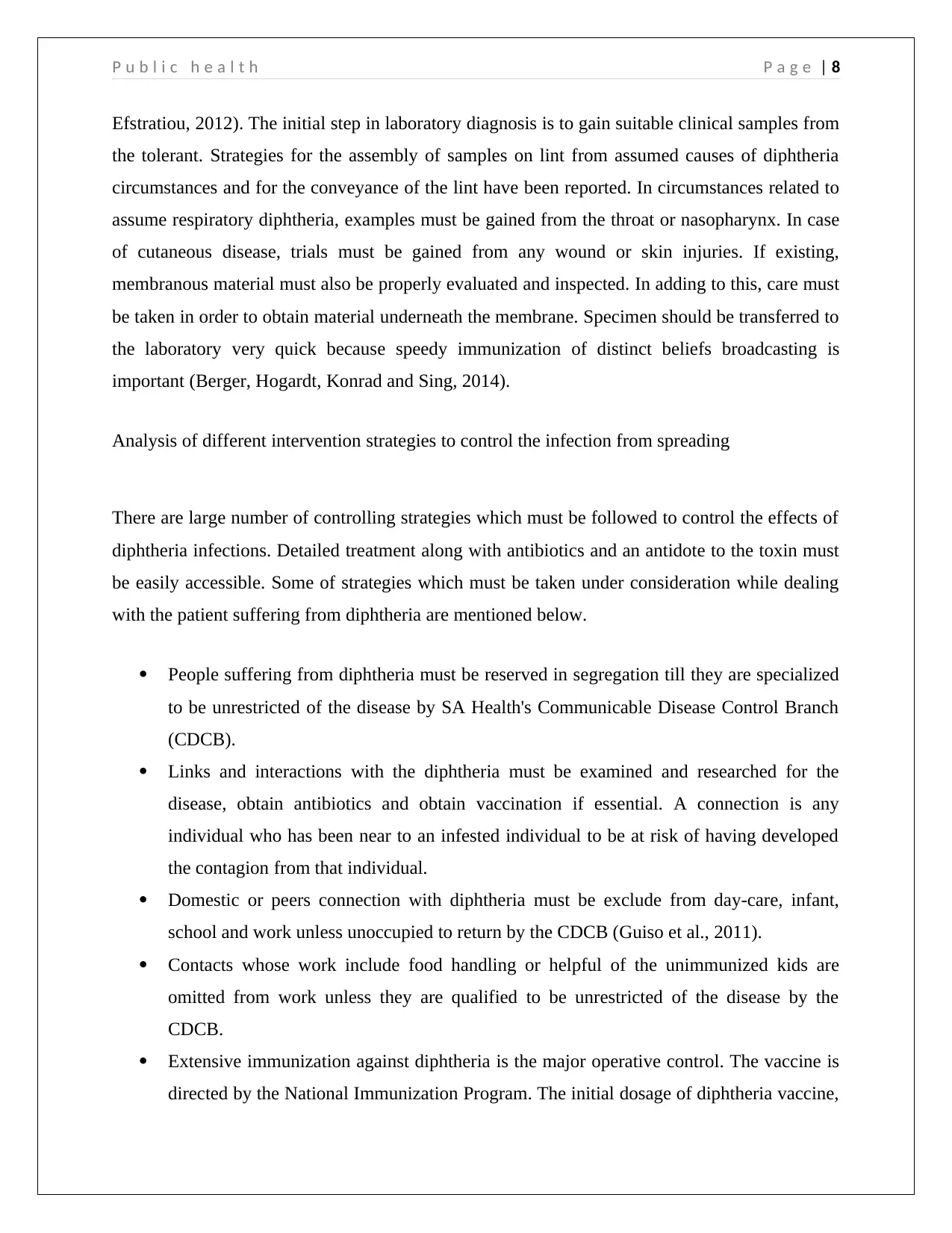
P u b l i c h e a l t h P a g e | 8
Efstratiou, 2012). The initial step in laboratory diagnosis is to gain suitable clinical samples from
the tolerant. Strategies for the assembly of samples on lint from assumed causes of diphtheria
circumstances and for the conveyance of the lint have been reported. In circumstances related to
assume respiratory diphtheria, examples must be gained from the throat or nasopharynx. In case
of cutaneous disease, trials must be gained from any wound or skin injuries. If existing,
membranous material must also be properly evaluated and inspected. In adding to this, care must
be taken in order to obtain material underneath the membrane. Specimen should be transferred to
the laboratory very quick because speedy immunization of distinct beliefs broadcasting is
important (Berger, Hogardt, Konrad and Sing, 2014).
Analysis of different intervention strategies to control the infection from spreading
There are large number of controlling strategies which must be followed to control the effects of
diphtheria infections. Detailed treatment along with antibiotics and an antidote to the toxin must
be easily accessible. Some of strategies which must be taken under consideration while dealing
with the patient suffering from diphtheria are mentioned below.
People suffering from diphtheria must be reserved in segregation till they are specialized
to be unrestricted of the disease by SA Health's Communicable Disease Control Branch
(CDCB).
Links and interactions with the diphtheria must be examined and researched for the
disease, obtain antibiotics and obtain vaccination if essential. A connection is any
individual who has been near to an infested individual to be at risk of having developed
the contagion from that individual.
Domestic or peers connection with diphtheria must be exclude from day-care, infant,
school and work unless unoccupied to return by the CDCB (Guiso et al., 2011).
Contacts whose work include food handling or helpful of the unimmunized kids are
omitted from work unless they are qualified to be unrestricted of the disease by the
CDCB.
Extensive immunization against diphtheria is the major operative control. The vaccine is
directed by the National Immunization Program. The initial dosage of diphtheria vaccine,
Efstratiou, 2012). The initial step in laboratory diagnosis is to gain suitable clinical samples from
the tolerant. Strategies for the assembly of samples on lint from assumed causes of diphtheria
circumstances and for the conveyance of the lint have been reported. In circumstances related to
assume respiratory diphtheria, examples must be gained from the throat or nasopharynx. In case
of cutaneous disease, trials must be gained from any wound or skin injuries. If existing,
membranous material must also be properly evaluated and inspected. In adding to this, care must
be taken in order to obtain material underneath the membrane. Specimen should be transferred to
the laboratory very quick because speedy immunization of distinct beliefs broadcasting is
important (Berger, Hogardt, Konrad and Sing, 2014).
Analysis of different intervention strategies to control the infection from spreading
There are large number of controlling strategies which must be followed to control the effects of
diphtheria infections. Detailed treatment along with antibiotics and an antidote to the toxin must
be easily accessible. Some of strategies which must be taken under consideration while dealing
with the patient suffering from diphtheria are mentioned below.
People suffering from diphtheria must be reserved in segregation till they are specialized
to be unrestricted of the disease by SA Health's Communicable Disease Control Branch
(CDCB).
Links and interactions with the diphtheria must be examined and researched for the
disease, obtain antibiotics and obtain vaccination if essential. A connection is any
individual who has been near to an infested individual to be at risk of having developed
the contagion from that individual.
Domestic or peers connection with diphtheria must be exclude from day-care, infant,
school and work unless unoccupied to return by the CDCB (Guiso et al., 2011).
Contacts whose work include food handling or helpful of the unimmunized kids are
omitted from work unless they are qualified to be unrestricted of the disease by the
CDCB.
Extensive immunization against diphtheria is the major operative control. The vaccine is
directed by the National Immunization Program. The initial dosage of diphtheria vaccine,
⊘ This is a preview!⊘
Do you want full access?
Subscribe today to unlock all pages.

Trusted by 1+ million students worldwide
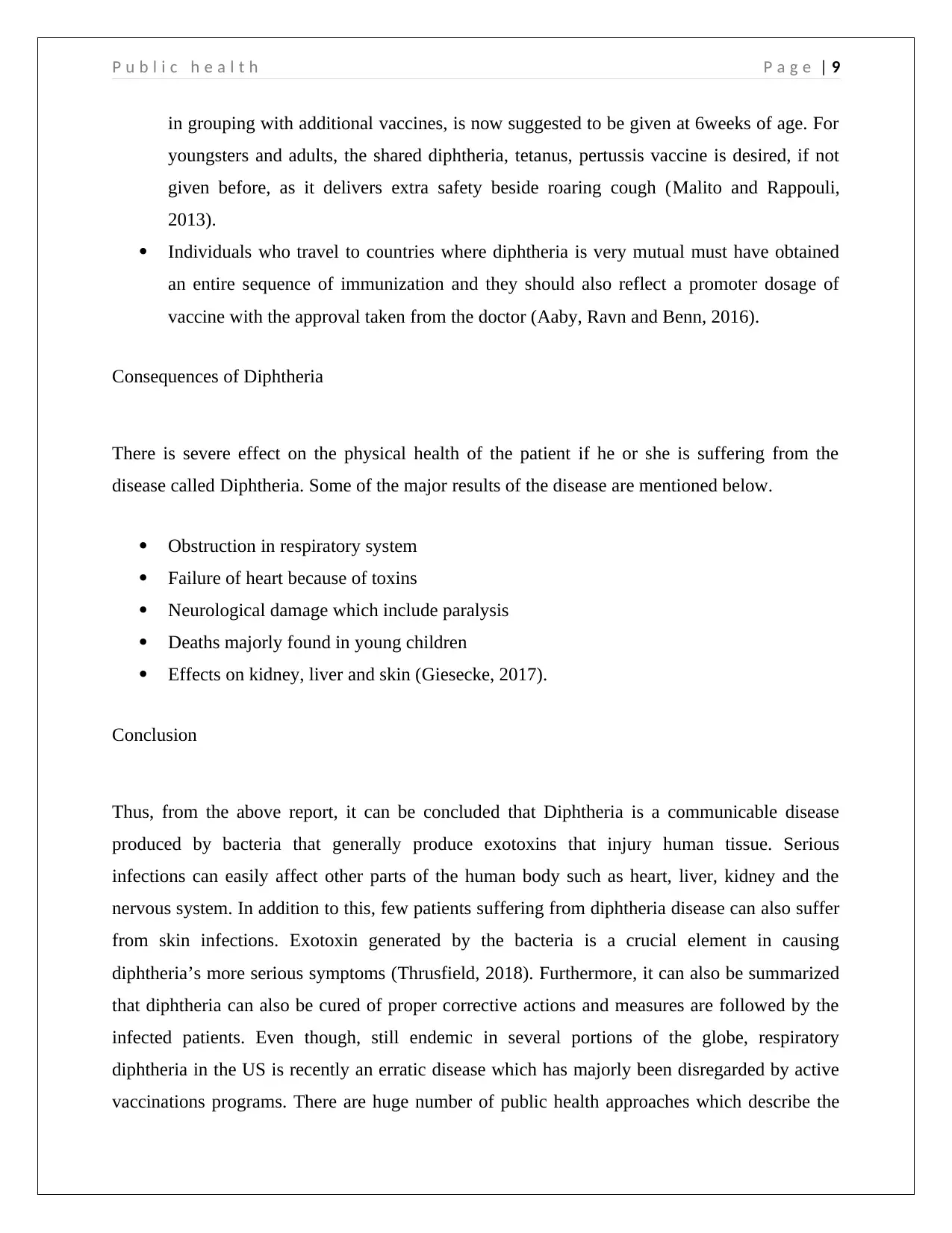
P u b l i c h e a l t h P a g e | 9
in grouping with additional vaccines, is now suggested to be given at 6weeks of age. For
youngsters and adults, the shared diphtheria, tetanus, pertussis vaccine is desired, if not
given before, as it delivers extra safety beside roaring cough (Malito and Rappouli,
2013).
Individuals who travel to countries where diphtheria is very mutual must have obtained
an entire sequence of immunization and they should also reflect a promoter dosage of
vaccine with the approval taken from the doctor (Aaby, Ravn and Benn, 2016).
Consequences of Diphtheria
There is severe effect on the physical health of the patient if he or she is suffering from the
disease called Diphtheria. Some of the major results of the disease are mentioned below.
Obstruction in respiratory system
Failure of heart because of toxins
Neurological damage which include paralysis
Deaths majorly found in young children
Effects on kidney, liver and skin (Giesecke, 2017).
Conclusion
Thus, from the above report, it can be concluded that Diphtheria is a communicable disease
produced by bacteria that generally produce exotoxins that injury human tissue. Serious
infections can easily affect other parts of the human body such as heart, liver, kidney and the
nervous system. In addition to this, few patients suffering from diphtheria disease can also suffer
from skin infections. Exotoxin generated by the bacteria is a crucial element in causing
diphtheria’s more serious symptoms (Thrusfield, 2018). Furthermore, it can also be summarized
that diphtheria can also be cured of proper corrective actions and measures are followed by the
infected patients. Even though, still endemic in several portions of the globe, respiratory
diphtheria in the US is recently an erratic disease which has majorly been disregarded by active
vaccinations programs. There are huge number of public health approaches which describe the
in grouping with additional vaccines, is now suggested to be given at 6weeks of age. For
youngsters and adults, the shared diphtheria, tetanus, pertussis vaccine is desired, if not
given before, as it delivers extra safety beside roaring cough (Malito and Rappouli,
2013).
Individuals who travel to countries where diphtheria is very mutual must have obtained
an entire sequence of immunization and they should also reflect a promoter dosage of
vaccine with the approval taken from the doctor (Aaby, Ravn and Benn, 2016).
Consequences of Diphtheria
There is severe effect on the physical health of the patient if he or she is suffering from the
disease called Diphtheria. Some of the major results of the disease are mentioned below.
Obstruction in respiratory system
Failure of heart because of toxins
Neurological damage which include paralysis
Deaths majorly found in young children
Effects on kidney, liver and skin (Giesecke, 2017).
Conclusion
Thus, from the above report, it can be concluded that Diphtheria is a communicable disease
produced by bacteria that generally produce exotoxins that injury human tissue. Serious
infections can easily affect other parts of the human body such as heart, liver, kidney and the
nervous system. In addition to this, few patients suffering from diphtheria disease can also suffer
from skin infections. Exotoxin generated by the bacteria is a crucial element in causing
diphtheria’s more serious symptoms (Thrusfield, 2018). Furthermore, it can also be summarized
that diphtheria can also be cured of proper corrective actions and measures are followed by the
infected patients. Even though, still endemic in several portions of the globe, respiratory
diphtheria in the US is recently an erratic disease which has majorly been disregarded by active
vaccinations programs. There are huge number of public health approaches which describe the
Paraphrase This Document
Need a fresh take? Get an instant paraphrase of this document with our AI Paraphraser
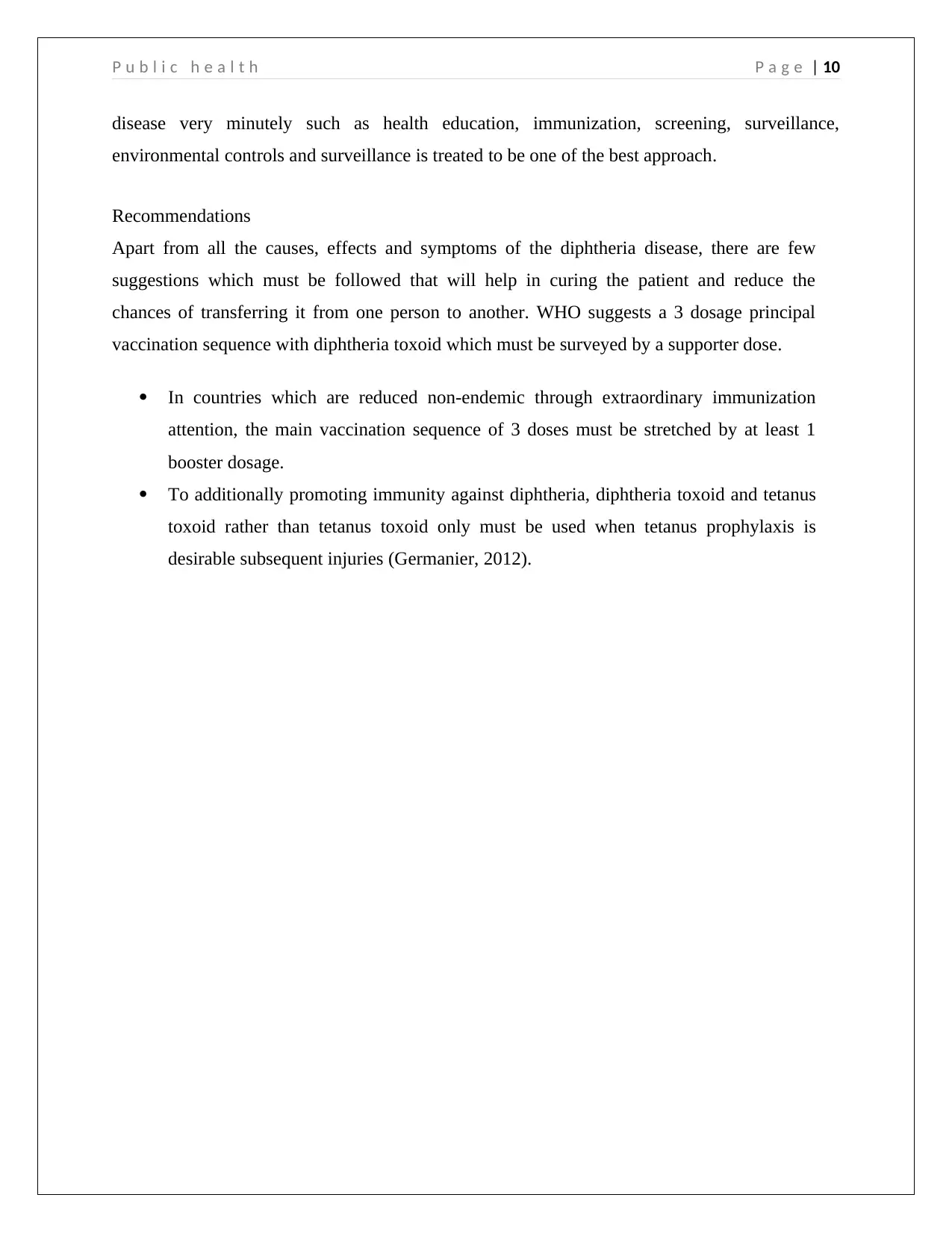
P u b l i c h e a l t h P a g e | 10
disease very minutely such as health education, immunization, screening, surveillance,
environmental controls and surveillance is treated to be one of the best approach.
Recommendations
Apart from all the causes, effects and symptoms of the diphtheria disease, there are few
suggestions which must be followed that will help in curing the patient and reduce the
chances of transferring it from one person to another. WHO suggests a 3 dosage principal
vaccination sequence with diphtheria toxoid which must be surveyed by a supporter dose.
In countries which are reduced non-endemic through extraordinary immunization
attention, the main vaccination sequence of 3 doses must be stretched by at least 1
booster dosage.
To additionally promoting immunity against diphtheria, diphtheria toxoid and tetanus
toxoid rather than tetanus toxoid only must be used when tetanus prophylaxis is
desirable subsequent injuries (Germanier, 2012).
disease very minutely such as health education, immunization, screening, surveillance,
environmental controls and surveillance is treated to be one of the best approach.
Recommendations
Apart from all the causes, effects and symptoms of the diphtheria disease, there are few
suggestions which must be followed that will help in curing the patient and reduce the
chances of transferring it from one person to another. WHO suggests a 3 dosage principal
vaccination sequence with diphtheria toxoid which must be surveyed by a supporter dose.
In countries which are reduced non-endemic through extraordinary immunization
attention, the main vaccination sequence of 3 doses must be stretched by at least 1
booster dosage.
To additionally promoting immunity against diphtheria, diphtheria toxoid and tetanus
toxoid rather than tetanus toxoid only must be used when tetanus prophylaxis is
desirable subsequent injuries (Germanier, 2012).
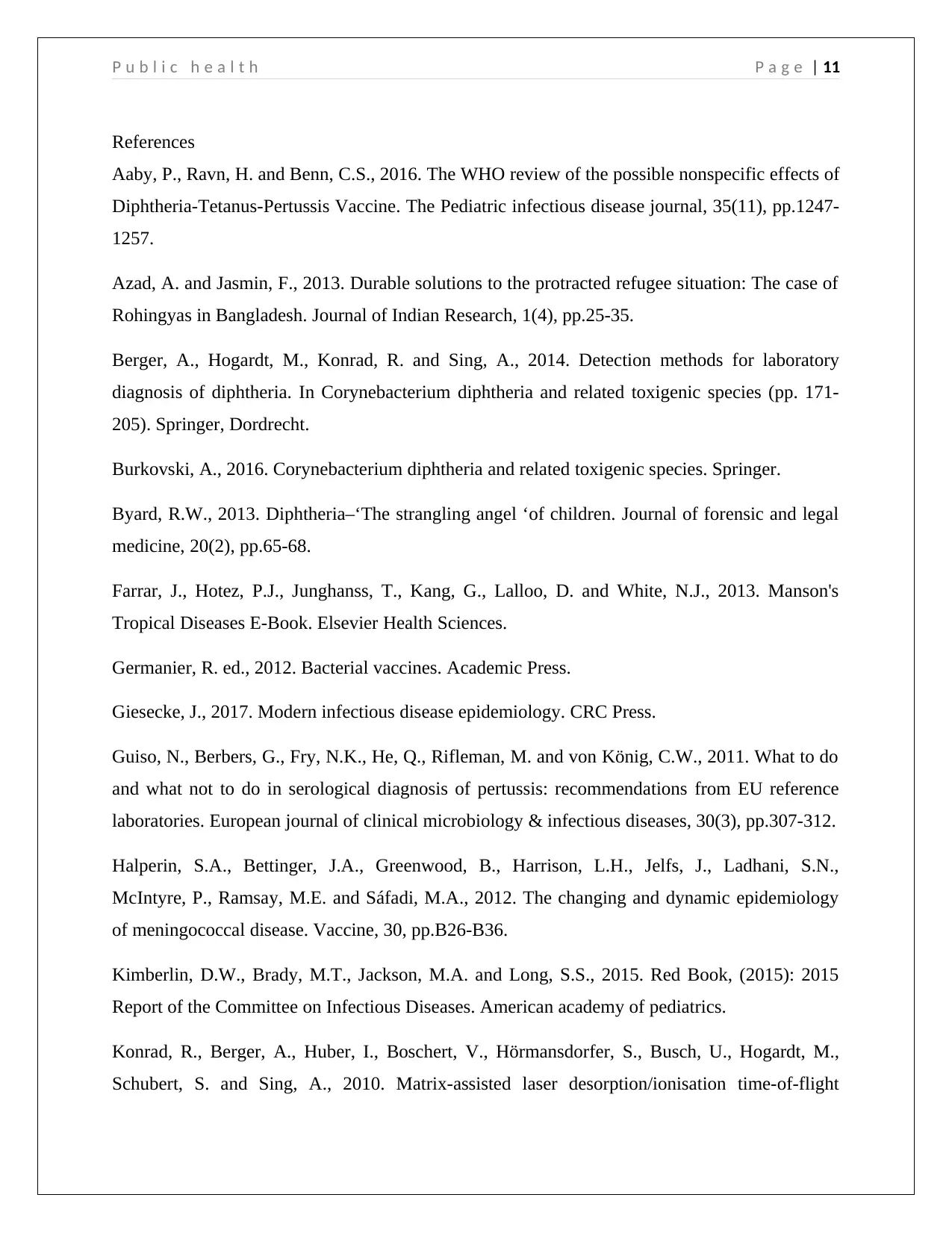
P u b l i c h e a l t h P a g e | 11
References
Aaby, P., Ravn, H. and Benn, C.S., 2016. The WHO review of the possible nonspecific effects of
Diphtheria-Tetanus-Pertussis Vaccine. The Pediatric infectious disease journal, 35(11), pp.1247-
1257.
Azad, A. and Jasmin, F., 2013. Durable solutions to the protracted refugee situation: The case of
Rohingyas in Bangladesh. Journal of Indian Research, 1(4), pp.25-35.
Berger, A., Hogardt, M., Konrad, R. and Sing, A., 2014. Detection methods for laboratory
diagnosis of diphtheria. In Corynebacterium diphtheria and related toxigenic species (pp. 171-
205). Springer, Dordrecht.
Burkovski, A., 2016. Corynebacterium diphtheria and related toxigenic species. Springer.
Byard, R.W., 2013. Diphtheria–‘The strangling angel ‘of children. Journal of forensic and legal
medicine, 20(2), pp.65-68.
Farrar, J., Hotez, P.J., Junghanss, T., Kang, G., Lalloo, D. and White, N.J., 2013. Manson's
Tropical Diseases E-Book. Elsevier Health Sciences.
Germanier, R. ed., 2012. Bacterial vaccines. Academic Press.
Giesecke, J., 2017. Modern infectious disease epidemiology. CRC Press.
Guiso, N., Berbers, G., Fry, N.K., He, Q., Rifleman, M. and von König, C.W., 2011. What to do
and what not to do in serological diagnosis of pertussis: recommendations from EU reference
laboratories. European journal of clinical microbiology & infectious diseases, 30(3), pp.307-312.
Halperin, S.A., Bettinger, J.A., Greenwood, B., Harrison, L.H., Jelfs, J., Ladhani, S.N.,
McIntyre, P., Ramsay, M.E. and Sáfadi, M.A., 2012. The changing and dynamic epidemiology
of meningococcal disease. Vaccine, 30, pp.B26-B36.
Kimberlin, D.W., Brady, M.T., Jackson, M.A. and Long, S.S., 2015. Red Book, (2015): 2015
Report of the Committee on Infectious Diseases. American academy of pediatrics.
Konrad, R., Berger, A., Huber, I., Boschert, V., Hörmansdorfer, S., Busch, U., Hogardt, M.,
Schubert, S. and Sing, A., 2010. Matrix-assisted laser desorption/ionisation time-of-flight
References
Aaby, P., Ravn, H. and Benn, C.S., 2016. The WHO review of the possible nonspecific effects of
Diphtheria-Tetanus-Pertussis Vaccine. The Pediatric infectious disease journal, 35(11), pp.1247-
1257.
Azad, A. and Jasmin, F., 2013. Durable solutions to the protracted refugee situation: The case of
Rohingyas in Bangladesh. Journal of Indian Research, 1(4), pp.25-35.
Berger, A., Hogardt, M., Konrad, R. and Sing, A., 2014. Detection methods for laboratory
diagnosis of diphtheria. In Corynebacterium diphtheria and related toxigenic species (pp. 171-
205). Springer, Dordrecht.
Burkovski, A., 2016. Corynebacterium diphtheria and related toxigenic species. Springer.
Byard, R.W., 2013. Diphtheria–‘The strangling angel ‘of children. Journal of forensic and legal
medicine, 20(2), pp.65-68.
Farrar, J., Hotez, P.J., Junghanss, T., Kang, G., Lalloo, D. and White, N.J., 2013. Manson's
Tropical Diseases E-Book. Elsevier Health Sciences.
Germanier, R. ed., 2012. Bacterial vaccines. Academic Press.
Giesecke, J., 2017. Modern infectious disease epidemiology. CRC Press.
Guiso, N., Berbers, G., Fry, N.K., He, Q., Rifleman, M. and von König, C.W., 2011. What to do
and what not to do in serological diagnosis of pertussis: recommendations from EU reference
laboratories. European journal of clinical microbiology & infectious diseases, 30(3), pp.307-312.
Halperin, S.A., Bettinger, J.A., Greenwood, B., Harrison, L.H., Jelfs, J., Ladhani, S.N.,
McIntyre, P., Ramsay, M.E. and Sáfadi, M.A., 2012. The changing and dynamic epidemiology
of meningococcal disease. Vaccine, 30, pp.B26-B36.
Kimberlin, D.W., Brady, M.T., Jackson, M.A. and Long, S.S., 2015. Red Book, (2015): 2015
Report of the Committee on Infectious Diseases. American academy of pediatrics.
Konrad, R., Berger, A., Huber, I., Boschert, V., Hörmansdorfer, S., Busch, U., Hogardt, M.,
Schubert, S. and Sing, A., 2010. Matrix-assisted laser desorption/ionisation time-of-flight
⊘ This is a preview!⊘
Do you want full access?
Subscribe today to unlock all pages.

Trusted by 1+ million students worldwide
1 out of 14
Your All-in-One AI-Powered Toolkit for Academic Success.
+13062052269
info@desklib.com
Available 24*7 on WhatsApp / Email
![[object Object]](/_next/static/media/star-bottom.7253800d.svg)
Unlock your academic potential
Copyright © 2020–2025 A2Z Services. All Rights Reserved. Developed and managed by ZUCOL.

